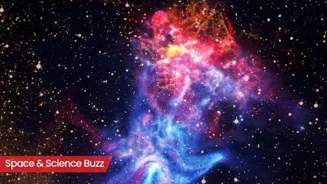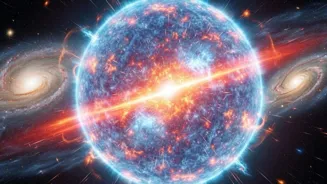Here are today’s most important updates from the realm of Science and Space.
Stunning NASA Image Reveals Giant ‘Hand of Stars’ in Space
NASA has released a stunning new image of what appears to be a colossal “cosmic
hand” stretching across 150 light-years of space, shaped by one of the galaxy's most powerful electromagnetic engines. This is the nebula MSH 15-52, first spotted by Chandra in 2009. It hides a pulsar at its center, a super-dense star just 19 kilometers across that was once a massive star and exploded, throwing its outer layers into space. New radio data from the Australia Telescope Compact Array (ATCA) have completed the picture, revealing the supernova remnants and their unusual properties. The combined Chandra and ATCA image shows the structure of the nebula, resembling a giant blue 'hand' reaching out toward a red cloud of gas.
From Old to Young: AI Makes Ageing Cells Youthful Again

In a groundbreaking announcement, OpenAI revealed a collaboration with Silicon Valley startup Retro Biosciences that led to the creation of GPT-4b micro, a specialised AI trained exclusively on protein sequences, biological literature, and 3D molecular structures. Unlike traditional chatbots, GPT-4b micro was engineered to redesign proteins central to regenerative medicine. Researchers deployed the system on a bold challenge: rethinking the Yamanaka factors, a set of proteins awarded the Nobel Prize for their ability to reprogram adult cells back into stem cells. In essence, the AI-created proteins made aged cells behave as if they were young again, a major stride toward therapies that could one day delay, or even reverse, aspects of human ageing.
Battery-Free Future: Household Devices May Soon Run on Indoor Solar Power

An array of personal and home devices could one day function battery-free following the development of pioneering new solar technology. These new solar cells are capable of harvesting energy from indoor light. Researchers said the discovery has broad applications and could enable consumers to power devices such as keyboards, alarms and sensors using only indoor ambient light. Researchers used the perovskite to gather light in solar cells. This material is already in use in other solar cells and offers distinct advantages to traditional silicon-based solar panels. In particular, perovskite absorbs lower-power, ambient light more efficiently than traditional methods, according to the study, making it ideal for indoor use.
Scientists Discover Body’s Own ‘Fat-Burning Switch’

Scientists have discovered a biological "switch" that could play a vital role in weight loss. The research highlights the importance of the amino acid cysteine, showing that its depletion can trigger the conversion of white fat, which stores energy, into brown fat, which burns calories and produces heat. This process, the researchers explained, helps make the body's metabolic functions more efficient, offering a new way to understand how calorie reduction leads to weight loss. While earlier studies suggested cysteine might influence fat activity, this is the first direct evidence of its key role. According to the team, keeping cysteine levels in check may serve as a new pathway for developing therapies to fight obesity and promote healthier metabolism.
















